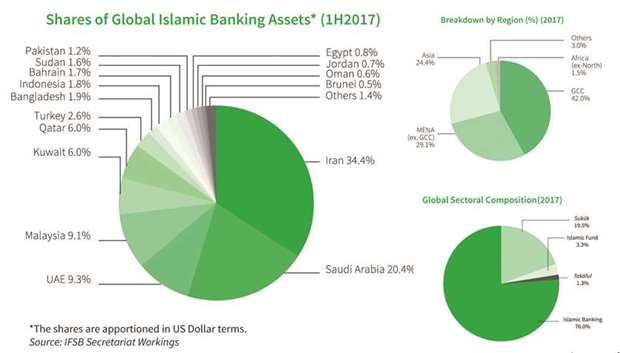The new Islamic Financial Services Industry Stability Report 2018 released by the Islamic Financial Services Board (IFSB) in Kuala Lumpur on June 8 confirms earlier forecasts that the global Islamic finance industry now has surpassed the $2tn-mark in assets across its three main sectors: Banking, capital markets and takaful.
Total assets were valued at $2.05tn as of the end of 2017, marking 8.3% growth in US dollar terms year-on-year and reversing the preceding two years of near stagnation of asset value of $1.89tn in 2016 and $1.88tn in 2015.
The report says that the strong growth momentum in Islamic finance is mainly owing to the global economic recovery in 2017 which had witnessed its most assured sign of business confidence since the global financial crisis in 2008 among most market participants. An increase in investment activities and manufacturing output, as well as some respite for oil-producing and oil-exporting countries from the improvement in crude oil prices during the second half of 2017 were also part of the positive picture.
“The Islamic financial services industry has demonstrated robust growth and resilient fundamentals in 2017, with growing market share and rising domestic systemic importance in many jurisdictions,” said IFSB secretary-general Bello Lawal Danbatta, adding that the issuance of the report “comes at a time of better-than-expected global economic performance in 2017, broadly led by a notable rebound in global trade as well as investment recovery in advanced economies.”
While Islamic finance saw overall improvement, the key rebound in performance was experienced by the Islamic capital markets segment, namely in sukuk and Islamic funds, whose assets grew by 25.6% and 19%, respectively, and – combined – represented 22.8% of the global Islamic finance services assets in 2017, up from 19.8% in the previous year.
The global Islamic banking industry experienced a 4.3%-expansion in assets to around $1.56tn, while the global takaful industry recorded a 4%-increase to close to $26.1bn (for takaful, data in the report is only available for 2016 over 2015).
In terms of global market share in Islamic banking assets, the report lists Iran, Saudi Arabia, UAE, Malaysia and Kuwait as the top five countries, while Qatar follows sixth. The other countries in the top-ten Islamic banking jurisdictions are Turkey, Bangladesh, Indonesia and Bahrain.
The report also notes that the industry has seen a couple of new additions of countries where Islamic finance made its first foray, namely Senegal, Bosnia and Herzegovina, Kyrgyzstan, Tanzania and Surinam, with the latter being the first South American country to introduce Islamic finance. Several more countries in North and Sub-Saharan Africa are currently making efforts to introduce Islamic banking services which would enhance the industry’s growth prospects in the future, the report says.
Regionally, the Gulf Co-operation Council (GCC) maintained its status as largest domicile for Islamic finance assets. In 2017, the region experienced a slight moderation in global market share to 42% from 42.3% over the previous year. The share of countries in the Middle East and North Africa (ex-GCC) has also slightly decreased, to 29.1% from 29.9% in the period.
Asia had the most improved market share, increasing to 24.4% from 22.5%, with expansions in key markets such as Malaysia, Indonesia, Pakistan and Bangladesh. Islamic finance penetration in other regions, including Africa (ex-North Africa), the Americas, Australia and Europe, while slowly picking up, remained nascent.
However, the report also has some words of caution which is directly connected to the growing systemic importance of Islamic banks in key markets. It noted that global Islamic banking “can no longer claim to be superior to conventional banking in all the stability dimensions,” most notably in terms of capitalisation and the non-performing loans ratio, issues which needed to be addressed on a regulatory level.

.
